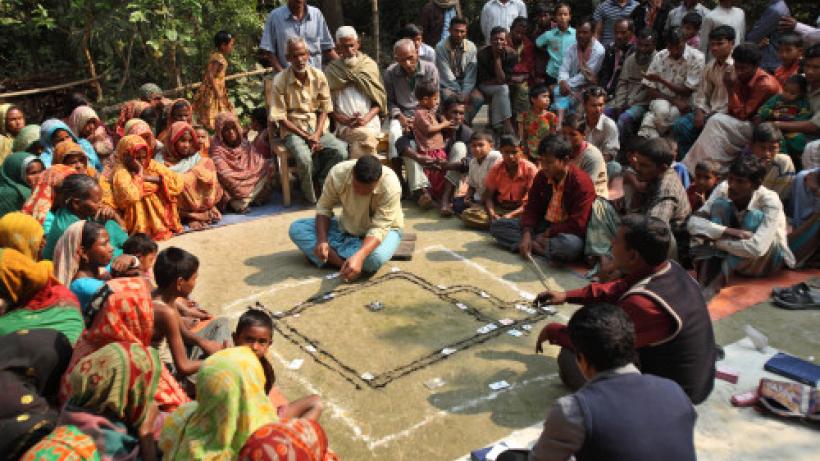
Manufacturing growth and the lives of Bangladeshi women
Rapid expansion of the ready-made garment sector in Bangladesh has radically altered the social and economic fabric of Bangladesh, particularly the lives of Bangladeshi women, who comprise the majority of the garment sector’s work force. This blog explores the effect of garment factories on the age of marriage and first child for girls exposed to garment sector jobs, particularly at ages when they are most at risk of early marriage and childbearing.
The garment sector was virtually non-existent in 1980 (Mostafa and Klepper 2009), but has grown an average 17% per year since inception, and now accounts for over 75% of Bangladesh's export earnings (Bangladesh Export Processing Bureau 2009). The garment sector has dramatically changed the composition Bangladesh’s labour force, and was the first industry to provide large-scale employment opportunities to women, in a country where women traditionally have not worked outside the home. Indeed, the industry currently employs almost 4 million workers (BGMEA 2013), 80% of whom are female. In addition to raising the opportunity cost of being married and having children, attractive manufacturing jobs require basic literacy and numeracy (Amin et al. 1998; Zohir 2001; Paul-Majumder and Begum 2006). There is reason to believe, then, that the arrival of garment factories has affected school enrollment, employment, marriage, and childbearing decisions for Bangladeshi women.
Our results indeed confirm that the rise of the garment industry can help explain declining fertility, increasing age at marriage, and increasing educational attainment. Extrapolation from our data and national surveys suggest that around fifteen percent of women nationwide between the ages of 16 and 30 work in the garment industry. Bangladesh has experienced rapid increases in girls' educational attainment over the last 30 years, both in absolute terms and relative to boys. This allowed the country to surpass the third Millennium Development Goal of gender equity in enrollments, a goal that many other countries in Western Asia and sub-Saharan Africa continue to struggle with.
In theory, access to factory jobs can alter women’s school, work, marriage and childbearing decisions through a few different mechanisms. As documented for maquiladora jobs in Mexico, older children may be induced to drop out of school to access factory jobs (Atkin 2012). Conversely, younger children (too young for factory jobs) are less tempted to drop out and instead may respond by investing in education if relatively well-paid manufacturing jobs offer increased returns to education. Educational attainment might also increase through a wealth effect, if parents can now better afford to send their children to school. Both the increased enrollment channel and the direct factory employment effects would result in girls delaying marriage and childbirth.
We examine the age at marriage and age at first birth for girls with greater lifetime exposure to factory jobs, controlling for both persistent differences between garment-proximate and control villages, and differences over time in garment-proximate villages. Using retrospective data from 1395 households across 60 Bangladeshi villages, outcomes are measured with respect to whether villages are within commuting distance of garment factories, and with respect to the date on which the first factories opened near each village. We document that the likelihood of marriage and childbirth at early ages (12-18) drops sharply for girls exposed to the garment sector.
Next we explore the mechanisms by which these delays in marriage and childbirth occur. To test whether education increased as well, we assess the effect of exposure to garment factory jobs on total years of educational attainment. Additional comparisons were made against the girls’ male siblings given that garment production has been a much larger innovation in the labor market for girls than boys (Amin et al. 1998). We find that girls gain an extra 1.5 years of education, relative to their brothers in the median garment-proximate village. This represents a 50% increase in girls’ educational attainment over control villages. Female education, relative to male siblings, increased even in families where the mother or older sister never worked in a factory. Thus it seems increased demand for skills in factories offering job opportunities for women is a likely channel through which enrollment gains are realized. This is in addition to any family wealth effects or changes in intra-household time allocation from other household members working in garment factories.
We next use retrospective data on the entire history of annual school enrollment decisions for each girl to test whether the effects of the garment industry on schooling are strongest for younger girls. We find girls (aged 5-9) are more likely to stay enrolled when factories are built close to their villages compared to girls in comparison villages that are not located within commuting distance of factories. Enrollment is similarly high relative to earlier years (before the factory opens), and relative to male siblings of the same age.
Our data also indicate that the delays in marriage and childbirth we estimate likely also stem from girls in garments-proximate villages (between the ages of 17 and 23) choosing to work in factories, instead of getting married or staying in school. Factory job access has a small negative effect on school enrollment of 17-18 year olds (unlike the positive effect for younger girls). Overall, girls exposed to factory jobs when they are at the critical age for early marriage in Bangladesh (between 10 and 23 years old) are 17 percentage points more likely to have done wage work outside the home, a 79% increase over the control group.
In summary, the garment sector has significantly lowered the risk of early marriage and childbirth while also increasing educational attainment for girls in Bangladesh. These findings may explain some of Bangladesh’s remarkable progress in improving women’s lives.

